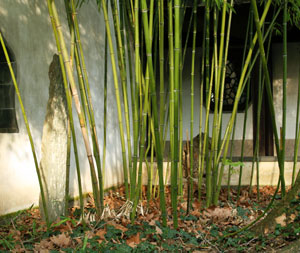

As the biomass becomes closer to the original level, more time is needed to achieve 100% complete recovery, and the gradual relationship with the recovery time can be shown by simulating the accumulation of biomass ( Poorter et al., 2016). In tropical secondary forests, the estimated return time is to 90% of that of the original biomass and not 100%. Franklin (2006) conducted harvesting experiments on wild Australian bamboo ( Bambusa arnhemica) and found that harvesting had no effect on the number of new bamboos, however the diameter at breast height was significantly smaller than that of the control. Proper rotation and cutting intensity could maintain sustainable wood production in bamboo forests ( d’Oliveiraa et al., 2013). The clonal integration of bamboo makes it possible to harvest the culms and shoots ( Franklin, 2006).įor forest management and disturbance care, bamboo cutting has affected biodiversity ( Zheng et al., 2022a), nutrient use efficiency ( Zheng et al., 2022b), and stand productivity ( Vangansbeke et al., 2015 Mao et al., 2017). This is the suitable width for bamboo forest strip cutting ( Zeng, 2019 Zhan, 2019 Wu, 2020 Wang, 2021). From the different experimental areas, the consistent conclusion drawn was that the structure of the new bamboo forest and soil environment is optimal and suitable for new bamboo development in plots harvested with 6–9 m bandwidth. Meanwhile, the quality of new bamboo deteriorated after cutting ( Zeng et al., 2019). Studies on the dynamic characteristics of bamboo recovery using different cutting widths showed that the number of shoots per unit area increased significantly the number of shoots and bamboo initially increased, and then decreased with increasing cutting intensity ( Wang, 2021).

Therefore, according to the physiological integration characteristics of Moso bamboo, bamboo forest management experts proposed a strip cutting method to reduce cutting costs ( Fan et al., 2018). However, the shortage of labor resources has become the main factor restricting bamboo cultivation and industrial development ( Zheng et al., 2021). Among them, there is 4.67 million hm 2 of Moso bamboo forests, accounting for 72.96% of the country’s total bamboo forests. According to the ninth Forest Resources Inventory report, China has a total of 6.41 million hm 2 of bamboo forests ( Administration, 2019). Moso bamboo ( Phyllostachys edulis) is an important forest resource in China and has important economic ( Jiang, 2007) and ecologic value ( Li et al., 2015). It was suggested that after three On-year restorations, the SC could reach the level of CK, however it is necessary to density manage RB from the second On-year after cutting. Further analysis showed that the increase in productivity in SC and CK was mainly from Moso bamboo at II and III “du”, which positively correlated with the soil contents of total nitrogen, total phosphorus, and available phosphorus. However, the number and productivity of new bamboo decreased significantly in the RB ( p<0.05), which reflected the density restriction effect of bamboo forest. Over time, the characteristics of new bamboo in SC reached the level of CK, and the density of standing bamboo, and productivity, were higher than those in CK. Cutting reduces the productivity of both SC and RB, and allocates more biomass to the bamboo leaves to capture light in SC ( p<0.05). The results showed that cutting increased the number of shoots and new bamboo, and decreased the diameter at breast height, height to crown base, and height of new bamboo ( p<0.05). The dynamic characteristics of stand, biomass distribution pattern, and productivity change in the different treatment plots were studied for 5 years after cutting. In this paper, plots with an 8 m width strip cut (SC) and respective reserved belts (RB) were selected as the research object, and the traditional management forest (CK) as control.

This is critical for formulating efficient bamboo forest management measures. Despite the rapid accumulation of Moso bamboo biomass, the dynamics of five years changes in stand characteristics and productivity after cutting remain unclear. Strip cutting can effectively reduce the cutting cost of bamboo forests and promote the transformation and upgradation of bamboo forests through mechanization and modernization. 2National Location Observation and Research Station of the Bamboo Forest Ecosystem in Yixing, National Forestry and Grassland Administration, Yixing, China.1International Center for Bamboo and Rattan, Key Laboratory of National Forestry and Grassland Administration, Beijing, China.Yaxiong Zheng 1,2 Shaohui Fan 1* Xiao Zhou 1,2 Xuan Zhang 1,2 Fengying Guan 1,2*


 0 kommentar(er)
0 kommentar(er)
